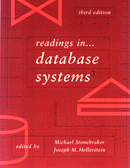Concurrency Control 3: Locking vs. Optimistic
Agrawal/Carey/Livny Performance Study: Locking vs. Optimistic
Previous work had conflicting results:
- Carey & Stonebraker (VLDB84), Agrawal & DeWitt (TODS85): blocking beats restarts
- Tay (Harvard PhD) & Balter (PODC82): restarts beat blocking
- Franaszek & Robinson (TODS85): optimistic beats locking
Goal of this paper:
- Do a good job modeling the problem and its variants
- Capture causes of previous conflicting results
- Make recommendations based on variables of problem
Methodology:
- simulation study, compare Blocking (i.e. 2PL), Immediate Restart (restart when denied a
lock), and Optimistic (a la Kung & Robinson)
- pay attention to model of system:
- database system model: hardware and software model (CPUs, disks, size & granule of
DB, load control mechanism, CC algorithm
- user model: arrival of user tasks, nature of tasks (e.g. batch vs. interactive)
- transaction model: logical reference string (i.e. CC schedule), physical reference
string (i.e. disk block requests, CPU processing bursts).
- logical queuing model
- physical queuing model
Measurements
- measure throughput, mostly
- pay attention to variance of response time, too
- pick a DB size so that there are noticeable conflicts (else you get comparable
performance)
Experiment 1: Infinite Resources
- as many disks and CPUs as you want
- blocking thrashes due to transactions blocking numerous times
- restart plateaus: adaptive wait period (avg response time) before restart
- serves as a primitive load control!
- optimistic scales logarithmically
- standard deviation of response time under locking much lower
Experiment 2: Limited Resources (1 CPU, 2 disks)
- Everybody thrashes
- blocking throughput peaks at mpl 25
- optimistic peaks at 10
- restart peaks at 10, plateaus at 50 – as good or better than optimistic
- at super-high mpl (200), restart beats both blocking and optimistic
- but total throughput worse than blocking @ mpl 25
- effectively, restart is achieving mpl 60
- load control is the answer here – adding it to blocking & optimistic makes them
handle higher mpls better
Experiment 3: Multiple Resources (5, 10, 25, 50 CPUs, 2 disks each)
- optimistic starts to win at 25 CPUs
- when useful disk utilization is only about 30%, system begins to behave like infinite
resources
- even better at 50
Experiment 4: Interactive Workloads
Add user think time.
- makes the system appear to have more resources
- so optimistic wins with think times 5 & 10 secs. Blocking still wins for 1 second
think time.
Questioning 2 assumptions:
- fake restart – biases for optimistic
- fake restarts result in less conflict.
- cost of conflict in optimistic is higher
- issue of k > 2 transactions contending for one item
- will have to punish k-1 of them with real restart
- write-lock acquisition
- recall our discussion of lock upgrades and deadlock
- blind write biases for restart (optimistic not an issue here), particularly with
infinite resources (blocking holds write locks for a long time; waste of deadlock restart
not an issue here).
- with finite resources, blind write restarts transactions earlier (making restart look
better)
Conclusions
- blocking beats restarting, unless resource utilization is low
- possible in situations of high think time
- mpl control important. Restart’s adaptive load control is too clumsy, though.
- false assumptions made blocking look relatively worse
- Final quote by Wulf!
|
